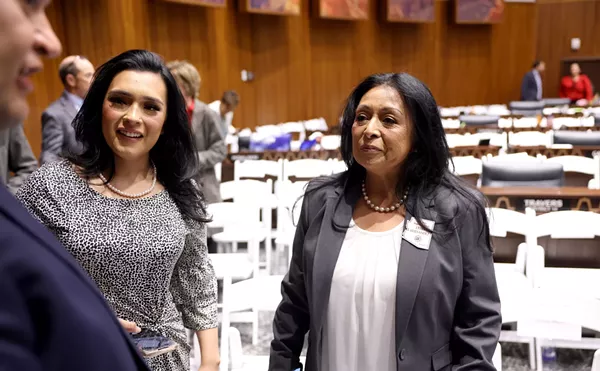By 4:30, they have gathered directly under the Loop 202, near Mill and Curry avenues. The teens -- almost all of them girls -- chat for a few minutes above the growing hum of traffic before getting to work.
At exactly 4:50 a.m., they step wordlessly into the parking lot behind the Marquee Theatre (formerly the Red River Music Hall). There, they form a circle and do some stretching exercises for a few minutes, then take off on a short jog around the empty lot.
On this day, July 11, their upbeat 31-year-old coach, Dan Duxbury, is waiting for them when they return, cup of lukewarm coffee in his hand.
"Gang, it's supposed to be 116 today," he says, gesturing to the brightening sky and chuckling. "But it's not there yet. Let's focus on what we're here for before it gets too hot, and go about our business."
Their business is making a sleek 200-pound boat called a shell go as fast as they can in an unlikely body of water called the Tempe Town Lake. The "gang" is the Tempe Junior Crew rowing team.
This unsung band of teens has earned its place as one of the Valley's more improbable athletic success stories, rowing competitively in the nation's most arid climate. The Crew, as they call themselves, continues to fare surprisingly well in regattas around the nation, including a few Sundays ago against stiff competition in Long Beach, California.
The rise of the privately funded team couldn't have come at a better time for the 35 girls who are part of the Crew. (Nine boys also are club members.) Mostly because of governmental pressure on the nation's universities to provide equal athletic opportunities to young women, rowing has become the fastest-growing collegiate sport in America.
A university can field a rowing team with 40-plus women at a relatively low cost. That helps it considerably in filling gender-equity quotas ordered under the controversial provisions of federal Title IX (controversial because certain men's sports such as gymnastics and wrestling have been trimmed or reduced to club status at several Division I schools).
Because of Title IX, college coaches have been scrambling to identify competent women rowers, even those who have been raised in the desert.
In the two years since the Tempe Junior Crew formed, its team members have won more than $500,000 in athletic scholarships to four-year schools. This fall, members of the Crew will be starting full rides at the University of California-Berkeley, Gonzaga, Loyola Marymount, and other prominent institutions.
"I played soccer for 11 years, but I wasn't going to get a scholarship at it," says Brittany McCain, an 18-year-old going into her senior year at Xavier College Preparatory. "With crew, if I stick with it, I think someone might offer me something."
If there's a more strenuous team-oriented sport on the planet, it doesn't come to mind.
"You can't think of yourself first in this sport because it doesn't work that way," says Anna Ward, a 17-year-old who also attends Xavier. "Not that I know anything about sports. But I have learned a whole lot about teamwork."
After the warm-up, the Crew heads back to its starting point beneath the freeway. The concrete area serves as the well-secured "boathouse" for the several Valley rowing clubs (and more than 40 racing boats of all sizes) that formed after Tempe Town Lake opened to the public in November 1999.
Eight of the girls gingerly lift the 60-foot-long Kaschper racing shell out of its rack, taking extra care not to bump or scrape it: Tempe Junior Crew leases the boat, which costs $25,000 new. The carbon-fiber oars cost $400 each.
Almost all of the girls are tall and muscular, averaging about 5 foot 10 and weighing 170 pounds. Watching and directing them is diminutive Tempe High senior Jake Zuniga, who weighs 120 pounds after a big meal.
Just outside the boathouse, Zuniga orders the girls to lift the boat over their heads, then to brace it on one shoulder or another. He is one of the Crew's coxswains, which means he serves as the team quarterback, in and out of the water.
In lock step, the girls slowly walk the boat down a winding paved road that leads to the lake.
Above them, the July sky miraculously has turned into a swirling mix of pinks and purples. Ahead of them, the string of lights on the Mill Avenue Bridge reflects off the water, creating a shimmering, starlit effect. A blessed breeze cools the air, if only briefly.
"They're the strength of the team, the beef," Zuniga says wryly, as the girls step onto the North Bank Boat Beach with their long shell. "I'm the brains of the operation. I'm short, I'm small, but I found my niche."
The girls await Zuniga's next command.
"Weigh enough," he tells them, invoking an old English rowing term that means to stop. "Walk it forward. Swing it in. Shoulders ready up, and walk it in."
Within a few minutes, Zuniga and the eight young women are ensconced in their shell, raring to go. Dan Duxbury putters up in his 15-horsepower aluminum jon boat, also called a coaching launch. He tells Zuniga what he expects out of the Crew during the first of four 1,000-meter drills -- at the start, then the number of strokes-per-minute after they get going.
It is seven minutes before sunrise.
Almost four years ago, the city of Tempe poured a billion gallons of water into a dry riverbed and called it a lake. It was an expensive proposition, about $45.5 million for starters (and $2.5 million each year in upkeep), almost all of it coming from taxpayers.
For the usual reasons -- economy, politics -- the city's preconceived notion of a cultural urban oasis at the Tempe Town Lake hasn't happened yet.
But the rowing's going swimmingly.
The lake is a little more than two miles long, and averages 900 feet across, starting from the east where the 202 crosses Indian Bend Wash, to just west of Mill Avenue. Buoys on the west end float near the once-proposed site of the Arizona Cardinals' football stadium, which the Federal Aviation Administration killed a few years ago by calling it a potential aircraft safety hazard.
Dan Duxbury's migration to Arizona in 1996 happened just as the city of Tempe was firming up plans for its new lake.
Born into a blue-collar family in Worcester, Massachusetts, Duxbury says he barely knew what an oar was until he went to college.
"My dad was a second-generation lineman for the phone company, and I was kind of a rebel as a kid. I went to the local college [Worcester State] because I didn't know what else to do. Rowing back East is just one of those sports there -- and not just an Ivy League, rich kids' deal. This guy came up to me in the first week of school and said they were looking for a small guy for the bow of the lightweight four [the four-man boat]. I had never rowed in my life, but what the hell. Then I got kicked off the team on the second day for coming in late to practice."
Luckily, Duxbury won reinstatement, and quickly got bitten by the rowing bug. He took a crash course in the sport, soaking in everything he could from veteran rowers at the team's boathouse on Lake Quinsigamond, about eight miles from campus.
Recalls Duxbury, "My home life wasn't the greatest and I didn't spend any more time there than I had to, so I became a boathouse rat. Some kids hang at malls. I hung at the boathouse. I got to know people who had been rowing for 60 years, and I learned how to fix and rig boats, how to paint boats, you name it."
He also learned how to row -- and well. In 1994, Duxbury qualified for a tryout with the United States national team in the lightweight division (he weighed 153 pounds at the time). But he says he had to turn down the invitation because he couldn't afford it.
"It really hurt not to go, to put it mildly," he says. "That experience is why I'm a big, big advocate of my kids coming to me and telling me if they don't have enough money to do something. I will not let what happened to me happen to anyone on our team -- ever."
Duxbury moved to Tempe in 1996 to complete his college degree at Arizona State University, where he majored in geography.
Duxbury had heard all about the new lake, but says the delays made him question whether serious rowing ever would happen there. He says he was about a month away from taking a federal government job in Manhattan in early 2000 when a buddy mentioned an advertisement in a local paper.
"The Tempe Parks and Recreation Department was looking for someone to coach a few rowing classes, and I got the job," Duxbury says. "I told myself, at least I can tell my friends that I actually coached rowing in the middle of the desert. Then, it turned into more than that."
Though he's largely self-taught, Duxbury also has been formally trained in how to coach rowing. In fact, he says proudly, he's the only coach in Arizona who has earned the highest level of certification from the U.S. Rowing Association.
"I started out flying by the seat of my pants back in Massachusetts helping coach the women's novices in Worcester," he says. "I think I know a whole lot more about what I'm doing these days."
Solely by word of mouth, Duxbury found enough desert kids -- those considered "at-risk" along with those from more stable and affluent backgrounds -- to start a rowing club. Working on a shoestring budget, Duxbury rented or borrowed equipment from other programs, as he trained his young charges in the highly technical science of rowing a boat fast.
But he says the city of Tempe wanted to keep things more recreational than competitive, which led to a friendly parting of the ways in December 2001.
"We were practicing six days a week, and doing in three months what it usually takes a year to accomplish," Duxbury says. "I wanted the whole goal of this program to be speed, and so did the girls who stuck around. They really wanted to race competitively. My friends back home thought I was nuts when I told them how much fun I was having. They pictured this dry lake where we would pretend that we are rowing."
Early last year, a few of the parents formed a board of directors, and helped Duxbury win nonprofit status for the Tempe Junior Crew. There's a $100-a-month fee for Crew participants, $60 of which goes to the coach and $40 to club fees (Duxbury will waive his coaching fee for Crew members short of cash).
The Crew receives no government funding, and Duxbury says his attempts to secure grant money and a corporate sponsor so far have failed.
"This is a tough economy, and it's been a financial burden for a lot of our kids," he says. "We've had generous parents who anonymously help out some of our less affluent kids, but we still have kids who won't be able to go to Long Beach, for example, because they have to save for a computer for college, or whatever."
As for himself, the coach says, "I'm not getting rich, but I can do this full-time thanks to my wife," referring to Susan White, a lawyer with the Arizona Attorney General's Office whom he married July 3. "And when we're out on the lake in the late afternoon and the traffic is zooming by, or creeping by, I think, God, this is a great gig.'"
Dan Duxbury's rowers invariably describe him as affable, positive -- and extremely demanding of them. He readily concedes the latter description.
"I like to say that the cream rises to the top and the rest drop," he says. "You're either with this program or you're not, no hard feelings."
On July 11, a few days before the competition at Long Beach, the coach steers his boat over to the eight-woman shell, where the Crew is about to run its first 1,000-meter of the morning (the sport is measured in meters, not yards).
He tells them, "The idea with the first couple of strokes is to convince the boat to get moving, to coax it, persuade it, like prying the bottle cap off a Coke bottle, tune in to what your hands are doing. At this level, you just have to be tuned in to something beyond yourself, have to be tuned in to the boat. Synchronicity is everything. I want you guys to look like you want to take it. You guys ready? Get the old feng shui going in the boat here, okay? Hands are down! Attention! Go!"
To overcome the shell's inertia, the eight girls have to use shorter, harder strokes at the start. One of the coxswain's jobs -- it's Jake Zuniga in this instance -- is to bark the desired speed and cadence over a so-called "cox box," an electronic device that amplifies his voice through speakers placed in the shell.
Zuniga has a small computer in front of him that tells him exactly how fast the shell is moving. He also steers the boat with a rudder the size of about four postage stamps.
"A cox has to be someone with a lot of self-confidence and who has no problem telling eight other bigger people what to do," Duxbury says, as the Crew propels the shell east on the lake past imposing Sun Devil Stadium. "He runs that ship, and is a consummate leader. Kind of a mix of a coach, a drill sergeant and a jockey, with a little psychology thrown in."
Zuniga wants to cox at the University of Pennsylvania after graduating next spring. Men's rowing is a cherished varsity sport in the Ivy League, though those eight schools don't offer athletic scholarships. Being third in his class at Tempe High and his rowing team experience won't hurt his chances of getting into Penn.
Zuniga and the other boys in the Crew recognize that their chances at winning college rowing scholarships are far more limited than their female counterparts. For starters, the NCAA doesn't officially recognize men's rowing (it does recognize women's rowing), and only a handful of universities outside of the Ivy League offer it as a fully funded men's varsity sport.
Each girl in the "8s" works one oar, seeking the harmony between finesse and strength in their four-part stroke -- catch, drive, finish and recovery.
Ideally, the blade should be the only part of the 12-foot oar that touches water during a run. Duxbury says that the longer it does stay in the water during a stroke, the faster the boat will go.
After about 500 meters, Duxbury bellows at his Crew like an irate football coach.
"I want you to sit like you're trying to squeeze a walnut between your shoulder blades. Step it up! Shake off those cobwebs! Show me something! In the back of my mind, I'm planning lineups for Long Beach. I've got 17 girls contesting for eight spots. If you want to be one of the eight, let me know!"
The Crew passes two elderly fishermen who are standing ashore, patiently waiting for the trout allegedly stocked in the lake to show an interest.
"The forearm is an extension of the oar," Duxbury tells Courtney Cox, who will attend Loyola Marymount University this fall on a rowing scholarship. "That was your analogy, Courtney. Now use it! You have to come out and prove yourself every day. Every day!
"Let the boat do its work. Yeah, now we're talking. Remember -- the boat's moving back and forth underneath you. Back those blades in. BACK 'EM IN! Ladies, I'm keeping notes. Boom! Take off like a rocket, girls. Go. Go. GO! You guys are like a fine Swiss watch, a Rolex. Indestructible!"
As the girls cool down for a few minutes after the drill, Duxbury lowers his voice and summarizes what he's just observed.
"Generally speaking, I wouldn't say that was stellar," he says, as they gulp from their water bottles. "The next start, I want to see waves clearing the puddles, to show me that you're doing your jobs. As it stands, none of you have a safe spot in the boat -- not one of you!"
The girl sitting in the "stroke seat" closest to Zuniga wipes some sweat off her brow and nods. At 5 foot 5 and 119 pounds, 18-year-old Aleisha DeCindis is the smallest girl in the shell, but Duxbury says she's one of the most powerful in terms of strength-to-weight ratio.
"She's a pit bull of a kid, a lot of character," Duxbury says of DeCindis. "She's like my right-hand man, so to speak, completely trustworthy. It just kills me that she's not going to row somewhere this fall."
A recent Tempe High graduate, DeCindis is one of three Crew captains appointed by Duxbury (Hilary Thornton and Megan Kohrs are the others), and has earned the respect of everyone around her.
But, the coach says, DeCindis' parents just don't want her to attend a university too far from their home in Tempe. So instead of going somewhere on a rowing scholarship, she's planning to enroll at Northern Arizona University, which doesn't even have a rowing club.
"Frankly, it makes me feel terrible for Aleisha," Duxbury says softly, before returning to his duties as Crew taskmaster.
Thankfully, the next 1,000-meter drill is much smoother, much more efficient -- and faster.
By 7:15 a.m., the Crew is off the lake for the day. They take their shell back to the boathouse, hose it down, dry it off, and safely tuck it away.
Jake Zuniga speaks to the rowers for a few minutes about how things went, followed by Coach Duxbury, who is back to his jovial, joking self.
Then they call it a morning.
Aleisha DeCindis stays an extra few minutes to go over some things with her coach. She is the epitome of what Duxbury wants in a rower, intensely loyal, strong and technically proficient. DeCindis first rowed at 15 when the lake opened, following in the footsteps of her father, who used to row in Pennsylvania.
With no financial help from her parents, DeCindis pays as much of the Crew's $100 monthly fee as she can by working at a day-care center a few hours every day. Knowing this, Dan Duxbury says he granted her a coach's scholarship, which means she doesn't have to pay him anything.
"Aleisha pays me back that $60 tenfold with her attitude and the help she gives me," he says.
Asked to explain her obsession with rowing, DeCindis says she doesn't know where to start.
"I'm just happy when I row, it's hard to explain. The thing I like the most is that if you don't have everyone with you, if one person is off, it completely disrupts the boat. It really takes a mental capacity. You're really not rowing as an individual. It's eight as one. It's a hazard to the boat if you're not thinking about what you're doing. When you're rowing, you're not thinking about your problems, not thinking about homework, and you don't care what other kids are doing or saying."
DeCindis says the greatest thrill in her life so far has been racing in Boston at the famed Head of the Charles regatta. "Can you imagine a girl from Tempe, Arizona, saying that she rowed a boat on a team in front of thousands of people in Boston, Massachusetts?"
She says she doesn't want to think about the possibility that her competitive rowing days may be done if she spends four years at NAU.
"I haven't dealt with that yet," DeCindis says, looking away. "I'll be coming down on weekends to the lake. I'll need something to do, so I'm looking into soccer. But rowing has been my life."
With that, she walks off to her car, still drenched in sweat.
Coach Duxbury watches DeCindis drive off.
"I'm not just teaching those girls and the rest of the kids how to pull on a stick that's going through the water," he says. "I think they're learning life lessons they're going to take everywhere."












